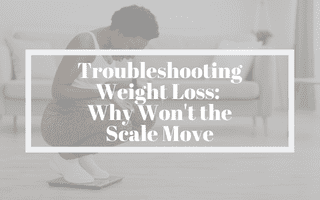One of the most frustrating things when you’re trying to lose weight is when you feel like you’re doing everything right, you hop on the scale, and…it hasn’t moved!
If you’ve ever found yourself standing nekkid in the bathroom wondering “why won’t the scale move?!” you’re in the right place!
Keep reading to find out some of the most common reasons the scale won’t move, many of which have nothing to do with you not losing fat!
If you prefer to listen, click here or the button below.
What the Scale Tells Us
The only thing that the scale tells us is how much force exists between your body and Earth at a single snapshot in time.
If it’s the only metric you’re using to track your progress, you’re in for a bad time (and a totally incomplete look at what’s actually going on).
The best use of the scale is to track trends over time, not to make you obsessive about day-to-day fluctuations.
How often you choose to use it is up to you but the sweet spot I’ve found with many of the women I’ve worked with is to weigh 3 times per week and take a weekly average.
Over the course of weeks and months, you want to be trending down but upticks are inevitable and nothing to freak out about.
Keep reading for 9 reasons why the scale won’t move – even if you’re actually making progress.
9 Reasons the Scale Fluctuates
These aren’t all the reasons why the scale won’t move up they’re some of the most common.
More Carbs Than Normal
For each gram of carb that your body holds on to, it also retains 3g of water. The less stored glycogen you have, the less water you’re retaining and vice versa. If you have a higher carb meal or couple of days, the scale will likely be up due to this but not because you’re gaining fat.
That fast initial weight loss you might see if you go on a lower-carb or ketogenic diet is just due to the loss of water when you deplete your glycogen stores – not actual fat loss.
Note: This is NOT to say that carbs are bad/to be avoided. A certain amount of carbs are necessary to help your body fuel for, and recover from, your workouts and busy lifestyle.
Sodium, Water Retention, Sweat, and Hydration
Since these are all related, we’ll cover them together:
Sodium pulls water into your cells so if you’re feeling swollen, bloated, or heavier after a meal or day of more salt than you’re used to, it’s likely due to water retention.
Keep this in mind after restaurant meals as they’re likely to be higher in sodium than from-scratch-home-cooked meals.
Sweat – another way your body loses water – can impact the scale, as well. Weighing yourself immediately post-workout when you’ve just sweated out a good amount of water can show a drop in weight that will be short-lived as soon as you rehydrate.
Conversely, chronic dehydration can slow or stall weight loss by slowing down digestion and various metabolic processes.
Hydration needs vary, but a good starting point is to aim for about half your bodyweight in ounces of fluid per day.
Gaining Muscle
Some (fortunate) people lose fat but gain muscle at a similar rate (called body recomposition), which means you may look and feel leaner, be losing inches, and fitting into smaller clothes, but not see many changes on the scale.
If you stay consistent, fat loss is likely to win out eventually so enjoy the easy muscle gain while it lasts.
Hormones
The changes in your hormones during your period can cause water retention and an alarming jump in the scale that can mask any fat loss that is actually occurring. As you move through your cycle, things will return to normal.
It’s helpful to track your cycles using a calendar or app so that you aren’t caught off guard when you see that jump.
In the long-run, compare your weight to the same week in your previous cycle. So compare cycle week 1 of May to cycle week 1 of June, that way you’re comparing apples to apples.
Stress, Cortisol, & Lack of Sleep
Constant stressors and lack of sleep can lead to chronically elevated cortisol, a hormone released when your body perceives a threat.
Among other things, this can dysregulate hunger hormones by increasing the ones that make you hungry.
In short, stress makes it harder to lose weight. So if your stress levels are drastically different from one week to the next, that could be playing a role.
Pee & Poop
Not much to say about this one but if you have a full bladder or bowels, that adds weight to the scale until you release them. If you’re really curious try weighing yourself pre- and post-BM and see the difference.
A Recent Meal
Having undigested food in your stomach can contribute to your scale weight, even though it’s not really a part of you.
Once that food is digested and the waste excreted, the scale will reflect that change. Compare your scale weight on an empty stomach and then again after eating if you’re curious about the effect.
What You’re Wearing
Maybe the most obvious but weighing yourself in a sweater, jeans, and boots, is going to show a higher output than weighing yourself nekkid. Put on your heaviest outfit and compare the two if you want.
You’re Actually Not Making Progress
It is possible that the scale isn’t moving because you’re not losing weight. If your weight trends over time reveal that you’re pretty much in the same place, even when accounting for fluctuations, it’s time to make a change.
Tracking your food is a great first step to figure out why the scale won’t move and what to do about it. Check out the following resources to help you:
Finding Your Calories and Macros
What to Track Besides the Scale
Remember that the scale is not the end-all-be-all. There are dozens of other factors that may be as – if not more – important as the scale weight.
Keep in mind that you don’t have to use a scale at all.
If it does more harm than good, stay off it & focus on other progress indicators like these:
Photos
Take full-body, front/side/back photos in the same outfit and lighting every 2-4 weeks so it’s easier to objectively compare changes.
Measurements
Take circumference measurements around your waist and hip every 2-4 weeks. Calf, thigh, chest, shoulder, arm, and neck are other areas to consider measuring.
For tips on accurate measuring, check out these Reels:
How to Take Accurate Body Measurements
Where to Take Circumference Measurements
Clothing
Try on the same article of clothing every 2-4 weeks to see how it may highlight changes in your body that you’d otherwise overlook.
Performance
Track the weights you’re using, speeds you’re running, output you’re cycling, etc. to help you gauge improvements to your fitness and strength.
Mood & Energy
Notice if you’re happier or more pleasant, slower to snap, feeling more outgoing or confident, no longer feel like you need to nap, etc.
Consistency
At the end of the day, none of the above will change without consistently nailing the “Big Rocks” of exercise & nutrition.
Create yourself some sort of basic tracker where you can jot down how many days you’ve hit your calorie and protein goals, step goal, etc.
If consistency isn’t your strong suit, consider joining us in Gone For Good. That’s my community for women who want to lose weight for the last time and live their healthiest, happiest, and most confident lives. Consistency is our superpower and we can teach you how to make it yours. Feel free to shoot me a message on IG if you have questions!




